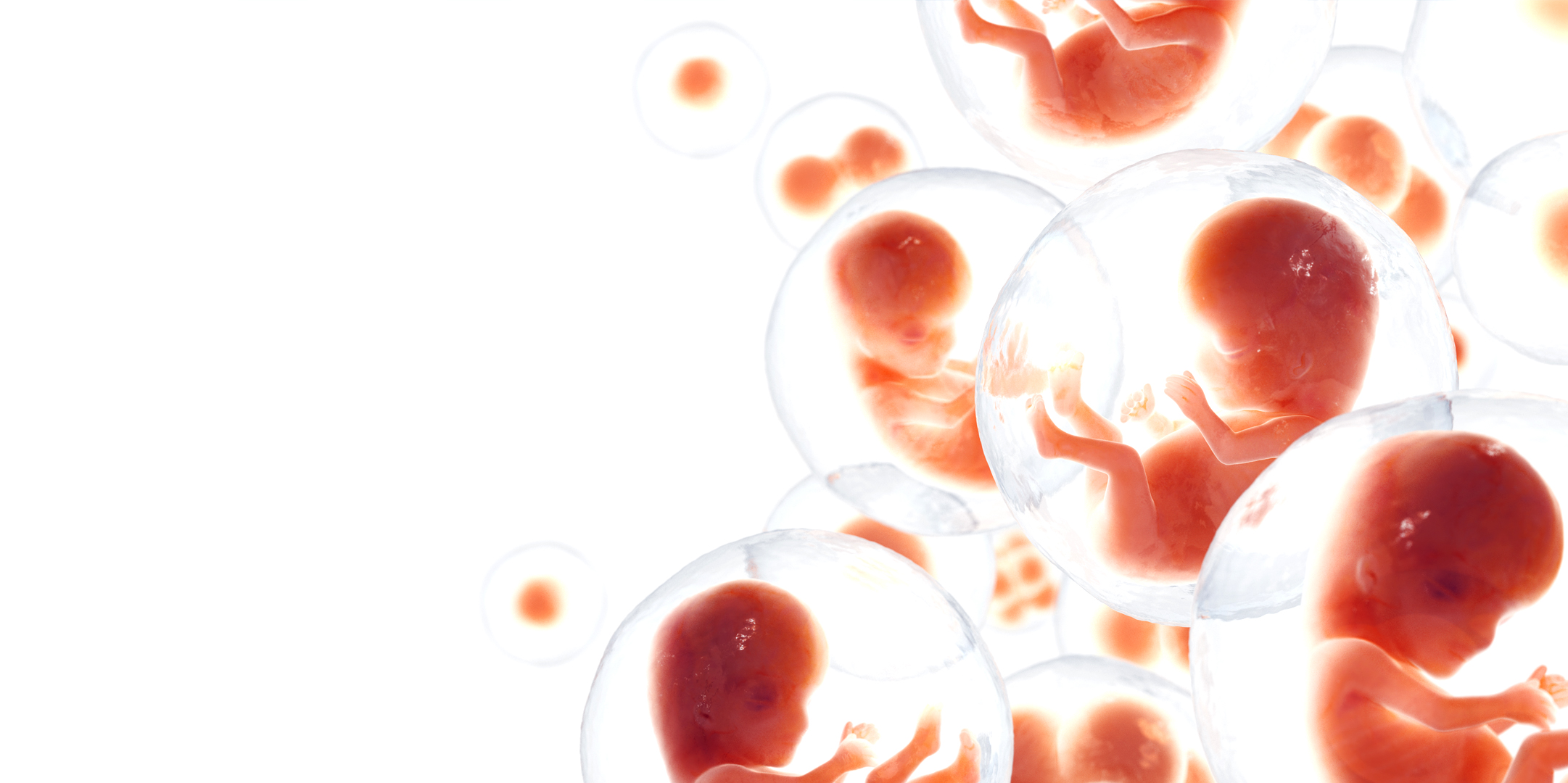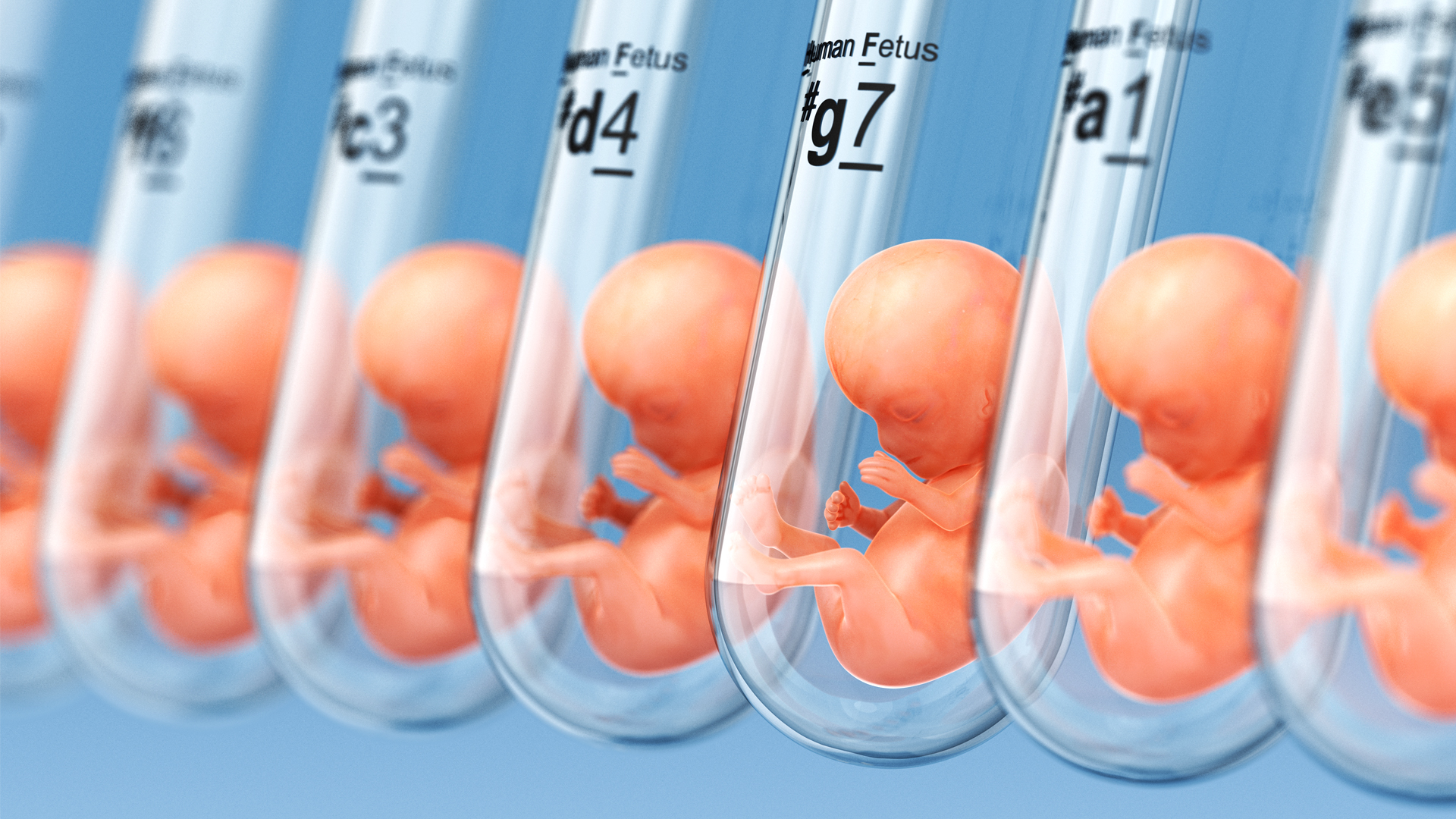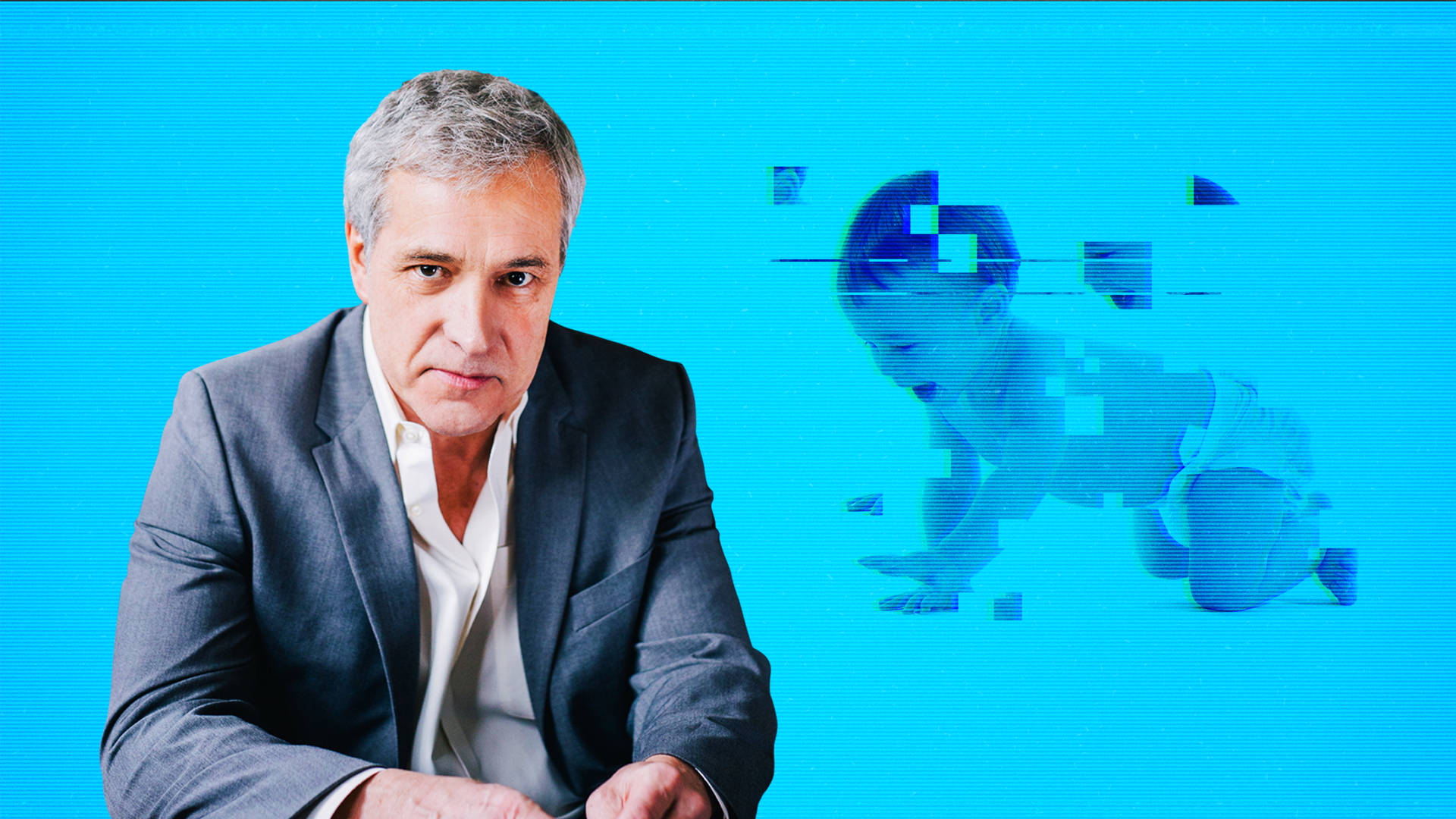Making a Better Baby
The Brave New World of Germ-Line Engineering
Researchers and policy makers around the world are struggling to determine how best to regulate germ-line editing of human embryos. What’s brave and new about that? Nothing, and everything.
We always want to make things better. Recreating the world according to both our needs and our abilities—straightening the crooked branch, as it were—is our long-standing pattern, with a particular focus on life around us. Although we’ve known about the twisting branches of the DNA molecule at the heart of our tinkering for only 65 years or so, we’ve been breeding and crossbreeding for millennia in hopes of producing the biggest, the smallest, the tastiest or the hardiest.
Moving on to gene-splicing and now gene editing, we continue to reconfigure species to fit our desires. Whether dog, fish, tomato or soybean, many species and crops being marketed today are the product of our own design. In the future we may even endow our creations with genes and chromosomes created from scratch. Artificial intelligence can already dissect protein structure and function; from this may come the ability to design new proteins and then, taking one more hereditary step back, build their corresponding DNA sequences. Inserting these into embryonic cells would give the adult organisms new capacities and metabolic pathways never seen before.
How might we engineer our future children and, by extension, the human family as technology opens new doors to prune and straighten the next generation? Just imagine the possibilities—and the pitfalls.
What would you be brave enough to do? Or not do?
“Trees grow in all kinds of ways. They’re not all perfectly straight. Not every limb is perfect.”
The Future Today
Consider organ transplants. Soon someone will receive the first heart or kidney grown in a pig. In this case the pig genome will have been altered to silence or remove proteins that trigger the patient’s immune response, thus avoiding patient rejection.
But why not just make the pig more human? Human-animal hybrids are controversial but not out of the question. How about adding human stem cells to chimpanzee embryos? Michael Crichton’s 2006 novel NeXT plays out just this kind of chimeric humanization-of-animals storyline.
We’ve not yet grown a transgenic organism to term, but someday we likely will. The scientific impetus to use such an integrated “platform” to understand more about brain development, for example, may eventually overcome the ethical questions that so often arise in the surrounding moral ether.
What will actually happen next in human applications? In the 20th century, the focus was on controlling the outbreak and spread of infectious disease. The discovery of antibiotics and the development of vaccines, as well as access to clean water, were pivot points in human health.
As we moved into the 21st century, attention shifted to the human cell. The infectious-disease assault will continue, but what if we could edit disease out of the human genome altogether? “This is such a fantastical thing to think about,” Jennifer Doudna told Vision in 2016. “You suddenly realize, ‘Wow, we have a tool that in principle allows us to change human evolution. We can wipe out a mutation from the whole population—just get rid of it.’”
Doudna, University of California–Berkeley professor of chemistry and molecular and cell biology, worked with Emmanuelle Charpentier (now at the Max Planck Unit for the Science of Pathogens in Berlin) to unlock the gene-editing potential of CRISPR-Cas9. “When we came across this protein in the bacterial immune system, we weren’t looking for that, of course,” Doudna explained; “but once we understood how it worked we realized this would be an incredible tool for genome editing. Because we can program it with this little piece of RNA, we can make a break wherever we want to.”
This means that scientists now have the molecular scissors and aiming system to make a specific edit among the 3 billion base pairs in our genome. Finding one particular letter in our DNA (the one incorrect letter on chromosome 11 that causes sickle-cell disease, for instance) is like finding one particular a in a stack of 900 Bibles; yet in any genome—animal or plant—CRISPR can find that letter and change it.
This has revolutionized biology, says Doudna.
“Now we have a tool that allows rewriting of the genetic code, changing the DNA in cells. That’s a profound thing. It allows scientists to do things that in the past would have been really hard or impossible.”
Escaping the Lab
Gene editing is not limited to the scientific community. The low cost of CRISPR and the relative ease of self-training has opened its use to almost anyone. The 2019 Netflix documentary series Unnatural Selection reveals just how fast the “democratization” of molecular science is moving. “We have no choice but to continue exploring the tree of knowledge,” says one geneticist, “but we always run the risk of discovering something that we cannot handle.”
DNA code is not like computer software. A person is more than code, children more than the genes inherited from their parents. Still, genes are critically important because the code they carry determines physiological parameters that affect our health and who we are. They do limit us in one way or another. A tall person is not going to be a champion jockey; a claustrophobe won’t be a good astronaut. We want to avoid disease, yet often the “crooked branch” is what gives us identity, individuality, even extraordinary gifts. The concern now is that definitions of disease and crooked might become quite malleable.
While it seems more practical and effective to invest in improving the social, cultural and mental environment that influences our well-being, we’ve emphasized the path to greater genetic influence. A decade before the advent of CRISPR, Gregory Stock recognized this fixation on the human genome: “The possibility of altering the genes of our prospective children is not some isolated spinoff of molecular biology but an integral part of the advancing technologies that culminate a century of progress in the biological sciences” (Redesigning Humans: Our Inevitable Genetic Future).
Thanks to gene-editing tools such as CRISPR, as well as an emerging kit of DNA-cutting proteins that are even more precise, the next generation of control has actually arrived. It’s no longer a question of “if” or “how”; now the questions are “Should we?” and “When?” Will we be able to collectively determine when it’s safe to proceed? And who will determine which traits to change? Scientific groups have proposed moratoria on experimentation while they struggle for answers. In the meantime, gene editing is going on off-campus, unsupervised, in garages and kitchens.
IVF and the Editing Window
In terms of therapeutic editing of patients’ cells (for example, immune cells removed from an adult and then returned to fight cancer) the cautionary lights have turned green, and many clinical trials are underway. But when to proceed with germ-line editing is trickier. Central to germ-line editing is the embryo; and in this case, creating the embryo is the job of in vitro fertilization (IVF).
Robert Edwards, the fertility pioneer who, with Patrick Steptoe, developed the first techniques of IVF, substantiated Stock’s view of the progression. Writing in 2004 concerning the potential therapeutic power of embryonic stem cells, Edwards noted that development in several fields of biomedicine hinged on past success with human IVF. Producing stem cells through the creation of embryos, he said, “had been among the primary intentions of introducing human IVF” (another, of course, was to help infertile couples have babies).

Having access soon after egg and sperm unite, when there are very few cells to “scissor,” makes it possible to change the trajectory of both an individual life and a family line. Because every cell of the body carries the same DNA information as the first, a change in those first embryonic cells becomes a change everywhere. It’s also possible to go back one more step: egg or sperm cells can be edited prior to fertilization.
Individuals created with any such alterations will pass them on to their children; by definition, these genetic modifications will become part of the germ line.
First Human Embryo Editing
He Jiankui, formerly a biophysicist at Southern University of Science and Technology in Shenzhen, China, calls the embryo-editing procedure gene surgery. “Gene surgery is another IVF advancement,” He says. “For a few children, early gene surgery may be the only viable way to heal an inheritable disease and prevent a lifetime of suffering.”
In 2015 the first report of human-embryo gene modification was published. Using nonviable IVF embryos from fertility clinics, other Chinese scientists had tested the accuracy of CRISPR edits in humans. This advance came surprisingly soon on the heels of Doudna and Charpentier’s discovery in 2012. According to Edward Lanphier, then president of Sangamo BioSciences, “the ubiquitous access to and simplicity of creating CRISPRs creates opportunities for scientists in any part of the world to do any kind of experiments they want.”
This early attempt at human germ-line modification prompted the first International Summit on Human Genome Editing (Washington DC, 2016). Following the summit, Doudna shared her concerns with Vision: “I would like to see the community of people—all of us who are now living in a world where we have this technology available—coming together to understand it well enough that we can think as a society about how to employ it in ways that will be beneficial to people and will cause, hopefully, no harm. We need to maximize the good while minimizing the risks and the dangers.”
At the time, Doudna was optimistic and generally confident that everyone could work together to move forward.
“We want to proceed in a way that is respectful of human life and that is cautious, but also appreciates that there are patients desperately waiting for treatments. We need to be balancing the benefits and the risks.”
Making the Case to Proceed
By what rules or principles should this science advance? At the Second International Summit on Human Genome Editing (Hong Kong, 2018), He Jiankui—also known as JK—planned to present a series of principles that he and his collaborators believed would provide a solid humanitarian and ethical basis for moving forward with germ-line editing.
In the paper, “Draft Ethical Principles for Therapeutic Assisted Reproductive Technologies,” He and his colleagues proposed that “a core set of fundamental human values” be set by the medical and patient communities to advance a dialogue about “the ethical use of ART [Assisted Reproductive Technology, including IVF] to help fertility-challenged couples conceive healthy children.” Parameters for “early-in-life genetic surgery” would be brief and simple so as to be accessible to the public: “Lawmakers in countries wishing to permit clinical trials and eventual regulatory submissions could build on these values to write cohesive rules that can still account for their country’s distinctive mix of religious beliefs, culture, and public-health challenges.”
Initially the paper, published in The CRISPR Journal, seemed reasonable enough: “Gene surgeries, including CRISPR gene editing and mitochondrial donation techniques, promise new therapeutic strategies during in vitro fertilization (IVF) to cure or prevent these diseases before a child can suffer.” The authors went on to ask, “What should be our proposed ethics and actual red lines?
They asserted, “We have thought deeply about ethical foundations for regulation in discussions between researchers, patients and advocates, and ethicists both in China and abroad.” One of those ethicists was William Hurlbut, who described his impressions of He in an interview with Vision: “JK is a very nice person to talk with and is sincere in wanting to do good. . . . He kept saying to me, ‘We have to get this moving along, because the science is safe.’ He was convinced the science was safe.”
JK’s paper suggested five principles for determining whether germ-line editing should be approved in any given situation:
- Mercy for families in need.
- Only for serious disease, never vanity.
- Respect a child’s autonomy.
- Genes do not define you.
- Everyone deserves freedom from genetic disease.
It’s hard to disagree with any of these ideas.
“We hold additional but less universal beliefs that further restrict the use of gene surgery,” the authors noted, “including the need to prioritize local population health needs and focus only on treating disease via prevalent, natural genetic variants.”
The Cart Before the Horse
As already noted, He Jiankui planned to present this material during the Hong Kong conference. In an e-mail to Vision, the moderator of the session, Robin Lovell-Badge (Francis Crick Institute, London), confirmed the timeline: “Yes, JK’s draft presentation did include a few slides on his view of the ethics of human germline genome editing. This was, according to Kevin Davies, the editor of The CRISPR Journal, always slated to be published around the time of the Summit meeting.”
Just as one of the major problems with CRISPR editing is the danger of “off-target” misedits of the genome, He’s plan unraveled when it became known that he had already used CRISPR nine months earlier to edit and implant embryos. News of the birth of twins, dubbed Lulu and Nana, became public on the eve of the conference.
Lovell-Badge continued, “I am fairly convinced that JK did not want the story of the babies to break until [a second] paper describing them was being published in a ‘top journal’—and he appeared genuine when he apologized that the story broke early.” Lovell-Badge has written an extensive account of behind-the-scenes meetings that took place at the time.
Was He Jiankui angling to create a kind of consensus supporting his ethics statements before his actions came to light? Had the scientific community supported his “Draft Principles,” it could arguably have helped both He and others justify what had been done. The principles, had they been sincere, might have paved the way for acceptance of germ-line editing.
According to Jon Cohen of Science, JK was also laying the groundwork for a kind of germ-line “tourism” business. Who knows how quickly we might have traveled that path had his timeline not tipped over? In failing to adhere to the cautionary principles that had existed by general agreement since 2016, he derailed any insight his “Draft Principles” might have provided; they have been dismissed as merely a bid to justify his own actions.
Citing He’s obvious conflict of interest, The CRISPR Journal retracted the paper. Its chief editor told Genetic Engineering and Biotechnology News: “The authors intentionally hid from us the fact that they were conducting clinical research on germline editing, and that babies had been born. . . . It is a mesmerizing gaze into the psyche of the authors before the news came out and how misguided they were.”
He Jiankui has been martyred as a rogue scientist, but his venture into the gene pool has made the waters even more enticing. If any Rubicon to germ-line editing existed, it has now been crossed.
“We have spent billions to unravel our biology, not out of idle curiosity, but in the hope of bettering our lives. We are not about to turn away from this.”
“It’s clearly turned up the heat,” Eric Juengst, director of the Center for Bioethics at the University of North Carolina, told Wired. “He’s leapfrogged the safety research that everyone was calling for. The pressure is increased to actually get that research done.”
“According to Juengst,” the article notes, “a world with enhanced humans via gene-editing is an inevitability. ‘People will have to learn to live in a world in which there are gene-edited fellow people among us,’ he said. ‘And that’s another focus that governments could take, to worry less about policing the science, and worry more about preparing society to live with this new kind of genetic diversity.’”
Is a Fifth Horse Out of the Barn?
New regulations may create hard lines against germ-line modification, but if Lulu and Nana are normal and healthy (which has not yet been independently confirmed), desperate and/or curious parents will find an avenue to give it a try. In his book Designing Babies: How Technology Is Changing the Ways We Create Children, Robert Klitzman of the Columbia University Medical Center notes how difficult it will be to close the now-open door to germ-line editing.
Pointing to weak regulations and the free-market approach to ART that exists in many countries, including the United States, Klitzman has little confidence that attempts to regulate future implantation of edited embryos will be effective. “Even the United Nations, with representatives from every country, has restricted powers,” he notes. “At some point, the transfer of gene-edited embryos into human wombs will probably be approved for use on an experimental or wider clinical basis—once its risks are better characterized, even though dangers will probably persist.”
Klitzman continues, “Many doctors and would-be parents prioritize patient autonomy over the rights of the future child, and minimize potential longer-term medical, psychological and social risks of ARTs. Given, in addition, the lucrative and competitive, profit-driven ART industry and its overall resistance to strong guidelines, numerous doctors might thus end up performing these procedures, with little regulatory or administrative hindrance” (Klitzman’s emphasis).
Assisted reproduction can do more than help infertile couples have a baby. It can help couples have the baby they want. So while we strive for health, there remains the question of whether we will objectify our children. Will we reduce them to products, fine-tuned, straightened and genetically honed to the parent’s recipe? In a consumer-conscious and market-driven world, a few may soon have both the economic and medical resources to purchase germ-line enhancements. One IVF parent explained his thinking to Klitzman: “If you’re paying to get a child, and this technology is there, why not use it? You go car shopping. You don’t just want something that has four wheels. You might want a Mercedes. That’s why there’s so many different kinds of cars. I don’t see anything wrong with it.”
Will we be brave enough to deny ourselves that future?
“Eat of the forbidden fruit, God warns, and ‘you shall surely die.’ Eat, promises the serpent, and ‘you shall be like God.’ That temptation—to be ‘like God’—is at the root of the ethical dilemmas posed by molecular biology.”
In a video that was meant to coincide with the preplanned public announcement of Lulu and Nana’s birth, He Jiankui made a poignant request. While there is collective skepticism about his motivations, his plea rings true—to remember that these babies are simply children for whom their parents believed they were doing the right thing. Did the parents understand the full implications of what he was asking them to undertake? Probably not, but desperate parents don’t always see beyond their hope for a well child; they’re apt to grasp at any offer of help.
“We hope that you have mercy for them,” He said. “Their parents don’t want a designer baby—just a child who won’t suffer from a disease which medicine can now prevent. Gene surgery is and should remain a technology for healing. [Enhancement] is not what a loving parent does. That should be banned.” He concluded, “I believe families need this technology and I am willing to take the criticism for them.”
Was this bravery or bravado? A self-serving sales pitch or an earnest plea? In time we’ll know whether He’s work was pioneering—or disastrous. In the meantime the research and the debates will continue.
“At this stage,” Doudna says, “I support the plans of WHO and the National Academies to recommend strict regulation that precludes use [of germ-line editing] until scientific and technical questions are addressed and until ethical and societal matters are resolved. I prefer this to a ‘moratorium’ which, to me, is of indefinite length and provides no pathway toward possible responsible use. Open discussion and transparency around this important topic should be encouraged, not suppressed.”
Can the conflicts of interest that obscure clearheaded discussion be overcome? Who will lead that discussion? Self-interest is a powerful motivator. Researchers would need to hold themselves back, especially from exploring genetic enhancement. To expect such a thing, however, is to believe that all of us will be willing to step back from the threshold. It seems more likely that some will want to use these new tools to try to straighten things that need not be made straight.
If there were a fifth horseman of the Apocalypse, perhaps he would be genetically modified and his horse spurred forward by self-deception. Is it bravery to forge ahead into a new world of human genetic modification that will lead, almost inevitably, to enhancement, or is it wiser to step back, to resist that temptation—to pull back on the reins and strive instead to be content with our variety, our limitations and our “crooked branches”? That is our collective challenge in this brave new world of making babies.



